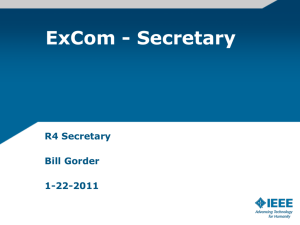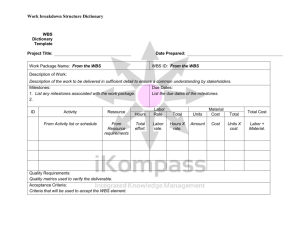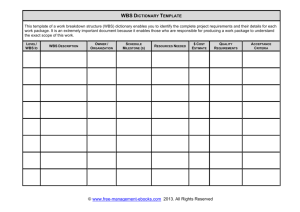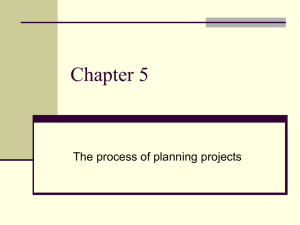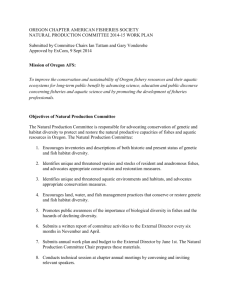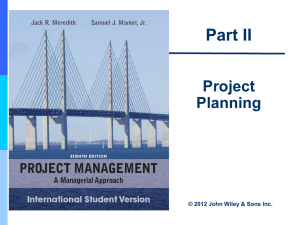4 - Project Management Procedure
advertisement
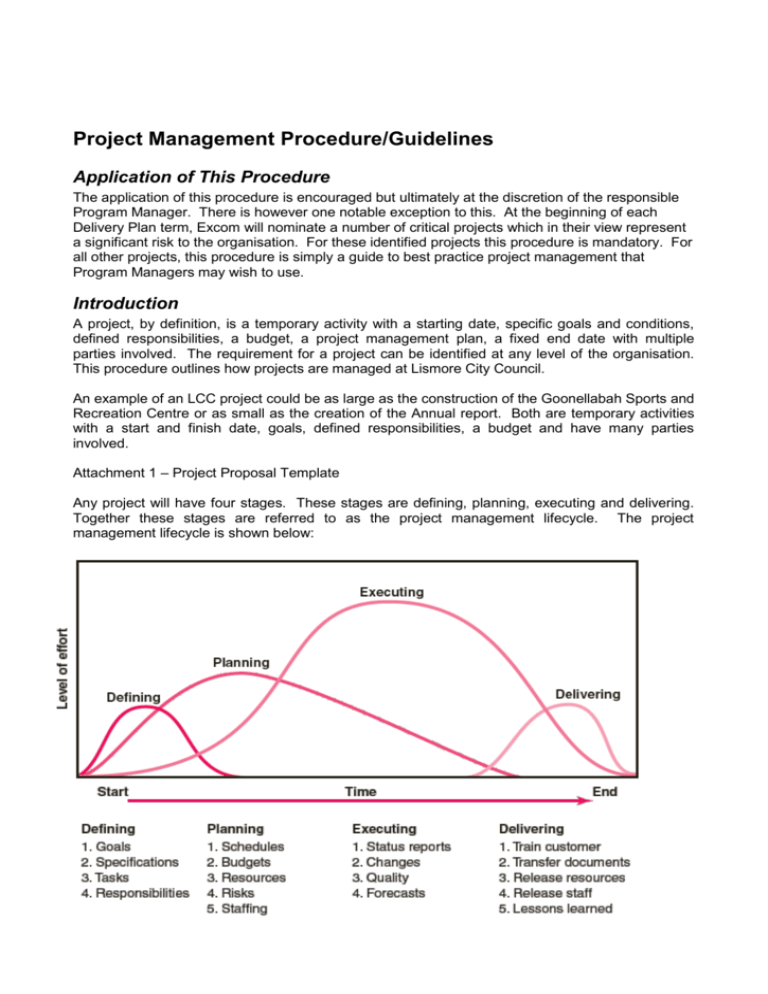
Project Management Procedure/Guidelines Application of This Procedure The application of this procedure is encouraged but ultimately at the discretion of the responsible Program Manager. There is however one notable exception to this. At the beginning of each Delivery Plan term, Excom will nominate a number of critical projects which in their view represent a significant risk to the organisation. For these identified projects this procedure is mandatory. For all other projects, this procedure is simply a guide to best practice project management that Program Managers may wish to use. Introduction A project, by definition, is a temporary activity with a starting date, specific goals and conditions, defined responsibilities, a budget, a project management plan, a fixed end date with multiple parties involved. The requirement for a project can be identified at any level of the organisation. This procedure outlines how projects are managed at Lismore City Council. An example of an LCC project could be as large as the construction of the Goonellabah Sports and Recreation Centre or as small as the creation of the Annual report. Both are temporary activities with a start and finish date, goals, defined responsibilities, a budget and have many parties involved. Attachment 1 – Project Proposal Template Any project will have four stages. These stages are defining, planning, executing and delivering. Together these stages are referred to as the project management lifecycle. The project management lifecycle is shown below: At LCC the project management lifecycle is defined by the acceptance of a number of documents. The defining stage of a project is completed with the signoff of the Project Proposal. At this point a broad budget and schedule will be set, the risks and stakeholders will be known. After signoff which will normally be in the form of the endorsed Delivery Plan or Operational Plan the planning phase of the project begins in earnest. The planning stage is completed with the signoff of the Project Management Plan. The Project Management Plan (PMP) will include the Work Breakdown Structure (WBS), the Project Schedule, Risk Management (risk identification, assessment and response) and the Communication Plan (both external and internal). For critical projects (as defined by Excom) the sign off of the PMP will be by Excom. For all other projects the sign off will be made by the nominated project steering committee. Project Proposal Once a project is identified it is documented using the project proposal template (Attachment 1). The template is used to identify the following. The project manager and project stakeholders. The scope statement - a brief statement which exactly encompasses what will be done and what outcomes will be achieved by the project. The project output - what the project will actually do. The project outcomes – what the project will actually achieve. The project costs over a four year period and the ongoing recurrent costs. The financial benefits of the project over a four year period and the ongoing recurrent benefits. The costs and benefits from a sustainability perspective. A project schedule outlining when the major project milestones will be completed. A risk management assessment identifying and ranking the major project risks. A measurement of success – the assessment criteria that will be used to measure how well the nominated outcomes of the project have been achieved. Any staff member can put up a proposal for a project providing they have approval from their direct supervisor to do so. The person who proposes the project will be responsible and accountable for the completion of the project proposal document and the preparation of supporting information and documentation. Once the project proposal is completed it will be presented to Excom if funds are required. Excom will assess the project’s viability and make a recommendation to accept, reject or defer the project pending the annual budget process. Where a project requires significant unbudgeted resources the decision to accept or reject the project may be made by Council. It is most likely that new projects will be considered as part of the development of the Delivery Plan or in subsequent Delivery Plan annual reviews. If a project is accepted then Excom will nominate a project manager. This person will then be responsible and accountable for the delivery of the project. Project Planning The output of this part of the process will be a full Project Management Plan (PMP). The PMP is effectively a much more detailed version of the Project Proposal. Once a project has been approved the Project Proposal template should be updated as the project planning is completed. On acceptance of a project, the Manager Corporate Services is available to help you through the planning process. Should you require any assistance, please do not hesitate to call. Project Team Nomination Once the project has been approved the next step is to nominate a project team. The project team will consist of the following roles: Steering Committee. – A group of senior staff responsible for the overall governance of the project. Project Sponsor. – Person ultimately responsible for the project and providing direction to the Project Manager. Project Manager. – Accountable to the Project sponsor for the day to day management of the project and the delivery of the project milestones. Project Officers. – Staff members reporting to the Project Manager responsible for the delivery of the project activities. The identified project team should be updated in within the Project Proposal Template. Scope Definition The scope definition is a contract between the project team and its stakeholders for the outcomes of the projects. Poor scope definition is one of the most common reasons for project failure. It is important that a clear and joint understanding of exactly what the project will deliver is shared by the stakeholders and the project team. The scope of a project is described within the WBS. Work Breakdown Structure The WBS defines all the elements of the project in a hierarchical framework and establishes their relationships to the project deliverables. The project is effectively a large work package. The WBS breaks this down into progressively smaller work packages. Below is a diagram which demonstrates how a project is broken down to a work package. A work package is a short duration task that has a defined start and finish point. Practice suggests that a work package should not exceed 10 days in duration. The work package is the basic unit used for planning, scheduling and controlling the project. The diagram below provides an example of what a WBS would look like for the development of a personal computer prototype. Creating a WBS from scratch can be a daunting task. To ensure that all perspectives are considered it is often best to produce a WBS from a group effort. For small projects this might involve the whole project team. With large projects specialist help may be required. As rule of thumb, the people who are responsible for the major deliverables should be involved in the creation of the WBS. Limitations and Exclusions The limits of the scope should be defined. Failure to do so can lead to false expectations and to expending resources and time on the wrong problems. When defining the scope, decisions will be made as to what will be done and what will not be done. It is important to record these decisions in the scope definition. Strategic Milestones To aid the governance and communication of the project the scope definition should conclude with a schedule of key milestones. These milestones should form the basis of any project progress reports. Estimating One of the most important skills that a project manager must have is to be able to provide accurate estimates of both time, and resource requirements. This section provides some guidance in how this can be done. With the WBS complete the next step is to put time and cost estimates to each of the work packages. These estimates will fold up into estimates for each of the deliverables and ultimately the whole project. Here are a number of points that should be used when estimating: 1. Responsibility. At the work package level, estimates should be made by the person most familiar with the task. This will often be the team leader or supervisor who is normally responsible for delivery. This has the added bonus of providing buy-in for the estimate from the person who is most likely to complete the work. 2. Use several people to estimate. Using a number of people gives a better chance of providing a realistic estimate. 3. Normal Conditions. When estimating, normal conditions should be assumed. This means the normal number of hours/work day or the normal amount of resources are available etc. 4. Time Units. All estimates should be in the same time units. A decision needs to be made early on in the project, what these units will be. It is normal at LCC to use days as the time unit. 5. Independence. Each work package should be considered in isolation. There is a natural tendency, especially from senior managers to make high level assumptions about the cost and time of a particular deliverable or sub-deliverable and then make the estimates of the work packages fit these assumptions. Considering each work package in isolation ensures that this does not happen. 6. Contingencies. Do not include allowances for contingencies in each work package. This leads to considerable over estimates. To allow for active management of budgets and schedules a contingency fund should be created to cover unforseen events. 7. Integrating estimates to risk management. Some estimates will be far less reliable than others. It is important therefore that estimates that are of a high risk of inaccuracy are included in the management of risk. This allows for these risks to be fully considered during the project implementation. To assist with estimating a spreadsheet has been developed which will help you considered some of the time and cost requirements of each of your work packages. Trim reference number ED10/25580 The Project Schedule The development of the project schedule has two steps. Firstly the sequence must be defined and secondly a time must be defined for each work package. Together these will provide a complete schedule for the completion of the project. The most efficient way for completing a project schedule is to use MS Project. Simply enter the work breakdown structure into MS Project. An example of the WBS of the personal computer prototype projects that was discussed earlier is provided below: The next step is to work out which order the tasks need to be completed. Once this has been worked out this is added into the “predecessors” column. So in this case the motor must be developed before either the circuit board or the read/write head can be started. The chassis frame can only be started once the circuit board is complete. Each of the work packages can only start on the pervious one is completed. The next step is to add the estimates made for each work package into the MS Project document. These estimates are entered into the “duration” column. The example of the personal computer prototype is continued: As you can see MS Project calculates the time required of each of the sub-deliverables, deliverables and ultimately the project as a whole. Project Budget In line with the project schedule a detailed budget should be produced. This should clearly indicate how much and when money will be spent. There will be some projects where cash flow may be an issue. In recognition of this project budgets should be developed in consultation with the Finance Section. The estimates for each work package can be entered into MS Project. For instructions on how to do this, please see the Manager Corporate Service. Project Resourcing It is important to understand the resourcing requirement for a project. MS Project makes this task quite straight forward. After the predecessors column is the resources column. This column allows you to select resources from the Outlook address book. Simply go through each of the tasks and assign a resource. You can then use on the canned resourcing reports to show you which resources are needed, when they are needed and for how long. The resourcing requirement should be included in the Project Management Plan. Communication Plan In any project the communication within, the project team, within the organisation and within the community, is a critical success factor. The development of the communications plan should be completed within the planning phase of the project. Where the project has an external element the Community Engagement Policy and Practical Guide must be used to develop the external communications plan. These guidelines provide an easy to follow framework for properly engaging the community in a project, gaining support for the outcomes and objectives. The communication plan should outline the following: Who are the stakeholders. All the stakeholders both internal and external stakeholders will be listed. How the project will communicate with the key stakeholders. The communication needs of each of the stakeholders should be assessed and strategies for this communication developed. How the project will communicate with the organisation. It is important that the organisation is informed of Council’s key projects. How and when this communication should take place should be included within the communication plan. How the project should engage with the community. Many of the major projects that Council implements have a significant impact on the community. Council has committed through its community engagement policy to engage with the community in these circumstances. The community engagement practical guide should be used by the project team to develop the projects community engagement. A full schedule for community engagement should be included within the communication plan and the project schedule. How the project will communicate with the media. In consultation with the Communications Coordinator a media plan for the project should be developed. How the project team communicate. Frequency of meetings, how risks and issues are dealt with etc. Risk Management Plan Risk management aims to maximise the results of favourable events and minimise the effects of adverse events. The risk management plan is a more detailed version of the risk management plan within the Project Proposal. This risk management plan should consider all the risks associated with the project and provide details of mitigation strategies. Using the three tables below the impact and probability are assessed. The results of these are plotted on the matrix contained in the third table. This gives a risk significance of between one and five, five being the most significant. Impact (The effect of the risk should it be realised) High More than $250,000 or impact the whole organisation or significant part of the Community Medium More than $30,000 or impact on several people in a department/Community Low Less than $30,000 and impact three or fewer people in one department/Community Probability (How likely this risk is to be realised) High over a 50% chance Medium 10% to 50% chance Low under a 10% chance Risk Rating (How significant the risk is) Low Medium High Low 1 2 3 Medium 2 3 4 High 3 4 5 All the risks associated with the project should be assessed in this way. The results should be listed in a table which describes the risk, the significance and the mitigation strategy. The risk management table should be regularly assessed during the project to identify any new risks, revise known risks appropriately and assess the effectiveness of the mitigation strategies. Project Implementation Once the Project Plan is complete and signed off by Excom or the Steering Committee the project should commence and be completed as planned. During this time: Regular updates on the progress of all aspects of the project (project schedule, budget, communication and risk management should be provided to the Project Steering Committee. Major issues with the implementation for the Project Plan should be reported to the Project Steering Committee. Major budget variations should be reported to the Finance Section. The communications plan should be regularly assessed for effectiveness and changes made if required. The project risks should be regularly assessed. New risks should be added, existing risks monitored and the success of mitigation strategies assessed and changes made if required. A project progress report based on the project milestones must be provided to the Manager Corporate Services at the end of each quarter. The progress of all projects will be reported to Excom. Project Change Management Process Because change is inevitable, a well defined change review and control process should be defined. At LCC any major changes to scope, budget or time need to be reported to Excom for critical projects and the Steering Committee for other projects, and in some cases to Council. Most changes fall easily into 3 categories: 1. Scope changes in the form or design or additions required by the customer. 2. The implementation of contingency plan when a risk even occurs. 3. Improvement changes suggested by the project team. Minor changes can be dealt with by the project manager of steering committee. However if a change is significant enough to go to Excom then the following information is required. 1. 2. 3. 4. Identify the proposed changes. List the expected effects of the proposed change(s) on schedules and budget. Who will be responsible for implementing the change. How the changes will be communicated. Excom or the project Steering Committee will either approve or reject the change. If the changes are approved then changes to the master schedule and budget will be made. Post Implementation Review Once the project has been completed and signed off by Excom or the Steering Committee, the outputs are assigned into an operational program. The last task of the project team is the completion of a post implementation review. A post implementation review is an assessment of all the activities of the project, it includes: Assessment of the delivery of the project outputs defined in the Project Plan. Assessment on whether the project was on-time and on-budget. Success of the project communication. Feedback for all the stakeholders. Documentation of any activities that are still to be completed. Recommendations for the operational Program Manager for the ongoing maintenance of the project outputs. The post implementation review should always conclude with the lessons learnt from the project from a project management perspective. Where there have been problems with the project these should be identified with recommendations for have these problems should be avoided in future projects. The post implementation review should also provide constructive feedback to Excom on any organisational issues encountered during the project and recommendations for resolution. Twelve Month Review With the project 12 months in operation an assessment should be made against the measurements of success outlined in the project plan. This should be reported to Excom or the Steering Committee with any gaps explained and any recommendations for required changes. Attachment 1 – Project Proposal Template Project Proposal Project Name Name Position Project Manager Internal Stakeholders External Stakeholders e.g. Councillors, Community Groups, Local Residents, All Residents etc. Primary Strategic Plan Link Secondary Strategic Plan Links Scope Definition Project Objective (A brief statement which exactly encompasses what will be done and what outcomes will be achieved Project Outputs (What will the project actually do) Project Outcomes (What the introduction of the outputs will actually achieve) Whole of Life Cost Benefit Analysis Does this project rely on existing staff resources? Yes/No (delete as appropriate) Project Costs in addition to Recurrent Budget Cost 2010-2011 2011-2012 2012-2013 2013-2014 Total Recurrent post 2014 cost Total Recurrent benefit post 2014 Total Project Benefits (Financial) Benefit 20102011 2011-2012 2012-2013 2013-2014 Total Non Financial Costs and Benefits Non Financial Benefits Social Participation Inclusion: Non Finance Cost and Sustainable Economic Growth and Development: Protect Conserve and Enhance the Environment and Biodiversity Best-Practice Governance Corporate Project Schedule Start Date Completion Date Major Milestones Date Output Risk Management Risk Impact Probability Risk Rating Mitigation Strategy See Matrix below for Impact Probability and Risk Rating (Some other common risks would be; Community discontent, poor media coverage, a business partner failing to deliver, bad weather, failure of technology, loss of political support, change in government etc, etc.) Impact High More than $250,000 or impact the whole organisation Medium More than $30,000 or impact on several people in a department Low Less than $30,000 and impact three or fewer people in one department Probability High over a 50% chance Medium 10% to 50% chance Low under a 10% chance Risk Rating Low Medium High Low 1 2 3 Medium 2 3 4 High 3 4 5 Measuring Success Outcomes Tangible Indicators of Success How Will These Be Measured
